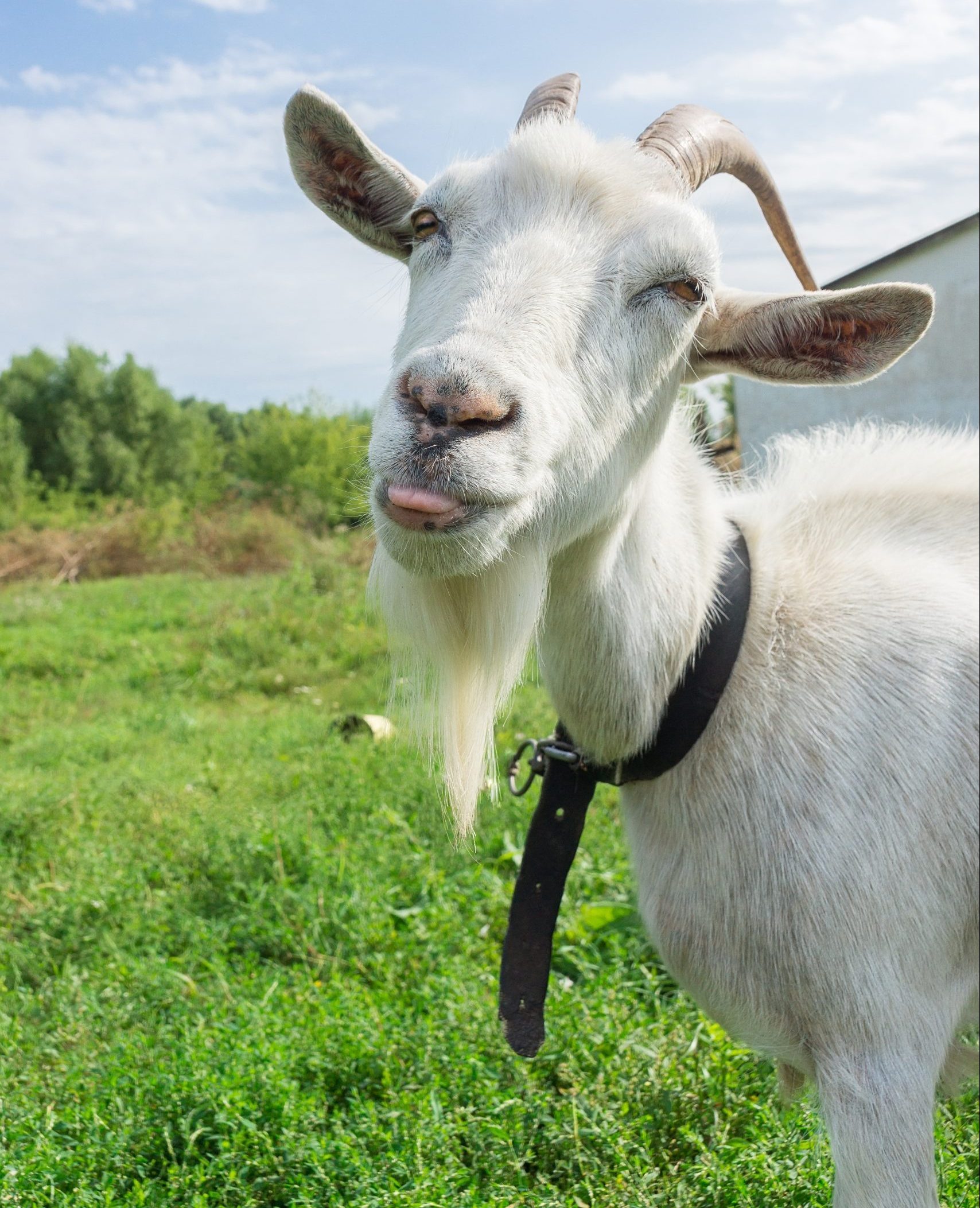Goat horns are unique anatomical features that can be beautiful and a bit hazardous, depending on how you plan to care for your goats. Learn why goats have horns, the difference between disbudding and dehorning, the pros and cons of disbudding, and the essential information on handling a goat with horns to ensure you handle them correctly.
Do All Goats Have Horns?
All goat breeds have horns. This includes the males (bucks and billies) and the females (does and nannies). Many may assume that only male goats have horns. This is inaccurate as both genders can grow them. The horns can be straight, gently curved, or curled.
However, while all goat breeds can have horns, not all goats will grow horns. Those that are naturally born without horns are known as polled goats.
Funnily enough, the North Dakota State University Agriculture and Extension refers to hornless goats as butt heads.
Now, you might assume that the “horned” gene (denoted by a lowercase “p”) is dominant in this livestock species because of how often people breed goats with this feature. Strangely enough, polled is actually a dominant gene, denoted by a capital “P.”
So, all the possible genetic scenarios in breeding goats would look like this (at least, as it pertains to the polled or horned trait):
- PP: A goat born with this gene combination would be polled and carries no recessive gene for horns.
- Pp: This goat would be polled and carry the receive horned gene.
- pp: Goats with this gene duo will have horns.
Depending on the parents’ precise genetic composition, your goat kids may or may not pop out with horns, even if their parents happen to be polled.
Goats of both sexes can be born with the necessary horned gene combination. So, don’t bet on your nannies being natural-born “butt heads” if you’re wary of this feature.
Instead, the only alternative you have to control horns’ presence is disbudding, discussed in detail below.
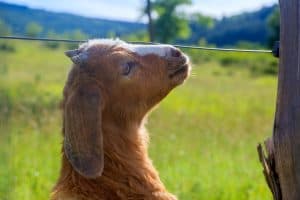
Goat Breed Types with Horns
As mentioned earlier, all domestic breeds of goats have horns. The only time you’ll see one without them is if they were born with two of the dominant gene for the polled characteristic.
Still, goat horns can appear very different between different breeds. Here are examples of four breeds to give you an idea of the distinct horn shapes:
-
Pygmy goat
These little buggers are a force to be reckoned with. They are small, but boy, if their energy doesn’t amount to several times their compact size! Their horns are just another element that contributes to their underestimated power. They’re generally straight but may curve outward, away from the head. Here’s everything you need to know about pygmy goats.
-
Nubian goat horns
These are popular dairy goats but nubians can be all-purpose (i.e., they’re great for meat and hide production as well). The Nubian goat breed has slightly curved horns beside their long, floppy ears. However, they are not as curled as the boer’s.
-
Boer goat horns
This is a very popular meat goat. It has a robust, stocky build, which carries through in its thick, backward-curved horns. Note that not all boer goats’ horns will appear this way. Some are shorter and narrower, appearing more straight and stocky, similar to a pygmy’s.
-
Girgentana breed horns
This breed gained international renown because of its long corkscrew horns. You’re unlikely to see this variant in the states, as this breed is of Italian origins.
For an even crazier example than the Girgentana, consider the four-horned goats. Breeds from the Alps are especially inclined to grow an extra few horns (a condition known as polycerate) because of a genetic mutation, HOXD1. This causes the goat (and some sheep) to grow horns on either side of its head.
As the goat develops during its embryonic stage, its horn buds split, leading to two too many horns as it matures.
Goat Breeds that May or May Not Grow Horns
-
Toggenburg goats
Some Toggenburg goats will grow horns and some will not. This goat breed is known for their dairy. The Toggenburg goat does produce a moderate amount of milk, making them ideal for small farms. You can cull unproductive does, wethers, and bucks you do not want to breed, for their meat.
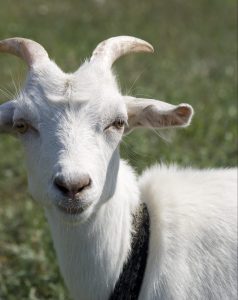
Why Do Goats Have Horns?
To understand why goats have horns, you must first learn its scientific classification. They belong to the family of animals known as Bovids, belonging to the group Bovidae. There are 140 individual species in Bovidae, goats being one of them (alongside sheep and cattle). One of their most common traits is the development of horns.
These horns are made of two layers:
- Inner core of bone
- Keratin (the protein that makes up hair, skin, and nails) sheath that surrounds it
A gap of air space separates the two, but the outer keratin covering never sheds. The entire horn is permanently fixed onto the front of the skull.
A few reasons this group of animals came to develop horns:
1. Sexual Competition
This is arguably the most important reason for horn development. To humans, it looks silly and merits a giggle when a tiny little pygmy goat is playfully butting heads with a companion on the farm.
It can be alarming when larger breeds, like Nubians and Boers, get in on the action.
Yet, realistically, this is a critical behavioral pattern that can make or break a male’s reproductive success. Since humans have taken over breeds’ continuity with artificial selection and breeding programs, the goats don’t have to worry about competing as much anymore. Out in the wild, though, it’s another story for Bovids.
2. Attracting Mates
As noted previously, male and female goats can grow horns. However, in general, male Bovids’ horns are significantly thicker and stronger than those of their female counterparts.
This is because the horns served not only as a tool in head-to-head combat for access to females but as an attractive physical trait. The bigger and stronger the horns, the more appealing the male is to available females.
3. Protection from Predators
Apart from reproduction, goats and other Bovids developed horns to protect themselves from predators. They use their horns for ramming and butting. Since they are all herbivorous prey species, they were targeted by incredibly strong carnivores. The horns were the best weapon they had to fight for their survival. Learn how long do goats live.
4. Goat Horns Help Keep Them Cool
Horns are air conditioning for goats. They help regulate body temperature. Scientists believe that one of the major reasons why goats developed horns is directly related to this anatomical feature’s vascularity (the extensive network of blood vessels). The goat’s horns help keep the animal cooler in hot months.
As the blood pumps through the horn’s core, a heat exchange occurs. This allows the blood to discharge the extra heat out and circulate through the body at a cooler internal temperature.
Handling Goat Horns
Knowledge of how to properly handle goat horns — and especially sharp horns — is essential to being a responsible livestock owner. Farmers, ranchers, breeders, and other agriculturalists have some slight differences in what they believe should and should not be regarded as standard handling procedures.
For instance, experts at the University of California, Davis, assert that the best way to hold a goat is by the horns. (That is, only when you are confident that the horns are securely attached. Otherwise, you might accidentally break them off.)
On the other hand, you and other agricultural professionals might not feel comfortable doing this. This is why it’s important to decide if you want to raise goats with horns.
Consider also fencing and feeders. Oftentimes, horned goats can become stuck in fences. They can be injured trying to free themselves. Predators can also maul them when they are stuck.
Horns can also hurt owners when they are working with the goat.
One tip is to wrap goat horns with duct tape or attach a ball — like a tennis ball — to the top. This can help lessen the damage goats do with their horns.
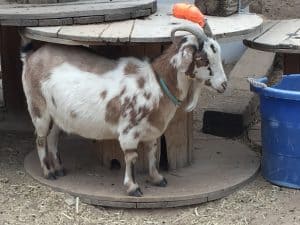
Disbudding vs Dehorning
There is a difference between disbudding and dehorning. While both are painful for the goat, disbudding is considered to be more humane. If you plan to raise a goat without horns, it’s best to disbud as soon as possible, in the first 4 – 10 days of life.
Disbudding
To disbud a goat or disbudding is when the goat horns are eliminated in kids or baby goats. They are burned off with a burning iron and don’t have a chance to grow. It’s a fast process.
All that remains is a bump where the goat horns would have grown.
Dehorning
To dehorn a goat or dehorning is when the goat horns have grown in and then are removed. This procedure is done on older goats with intact horns. They weren’t disbudded as kids.
Dehorning a goat is far more dangerous and is performed after disbudding is no longer possible—after the horn buds erupt. There are many techniques, all essentially involving cutting off existing horns. This cutting is often traumatic for both the animal and its owner.
It’s best to have a veterinarian do this in order to sedate the goat to make it less traumatic and less painful, to help with blood loss, and to ensure it’s done correctly.
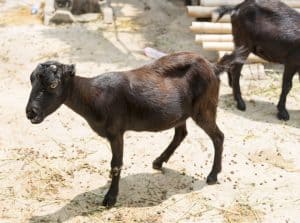
Pros and Cons of Disbudding
Disbudding is a hot-button topic between rural folks and many others. For many, it’s a normal part of life that does not impede the animal’s quality of life.
However, some view disbudding as a violation of animal rights and urge livestock owners to abandon the practice altogether. While this perspective is justified, so is the other in support of the practice.
Below are some pros and cons to consider before you settle into a stance on this matter.
Pros of goat debudding
- Other animals on your farm will be much safer if your goats—especially the males—no longer have horns to ram them with.
- The disbudded goats will be substantially safer, as they face less risk of incidents like getting caught on fences.
- Your safety will increase by removing goats’ horns. You will not have to worry about you or small children getting rammed by ornery livestock. Plus, you won’t be at risk when you bend over or near one of your goats to care for its hooves or tend to another grooming task.
- Interestingly, researchers found that polled goats required less space for feeding, mainly because of behavioral changes associated with a natural lack of horns. Of course, it’s hard to say whether the same phenomenon would apply with disbudded goats.
Cons of goat debudding
- Scientists have not yet learned how to perform a disbudding procedure in a way that minimizes or eliminates the goat’s pain. Your kid or adult will inevitably be hurt and uncomfortable for quite a while following the horns’ loss.
- If you have a large property with a high risk of predator invasions, your goat will not have a reliable way to protect itself. A horned goat does not need to rely on livestock guardian animals and other defenses as heavily.
- Disbudding must occur within a few days of birth. It requires planning.
FAQs
Do female goats have horns?
Yes, does as well as bucks from all breeds can grow horns.
Why do they cut off goat horns?
In general, it’s safer for goat owners to raise goats without horns. The owner will be at less risk of injury. Also, goat horns can become stuck in fencing which can injure the goat.
What is a goat with horns called?
All types of goats can grow horns. All breeds are naturally horned. However, some goats will never grow them. A goat without horns is called a polled goat.
What do goat horns mean?
When you see a goat with horns, it means the owner didn’t disbud or dehorn them. The horns help the goat by regulating heat and keeping the goat cooler. It also means the animal will have some protection from predators as it can use the horns to defend itself.
Are goat horns dangerous?
Goat horns can be dangerous for the family raising goats as well as other animals on the farm. They can be dangerous for the goat if there is fencing or other areas in which the horns can become stuck.
However, some owners believe it’s worth the risk to keep the horns intact. It’s a personal preference based on the property, other animals, predators, etc. Keep goats entertained and happy with a goat playground. It will help keep them mentally stimulated and active which can reduce stress and destructive behaviors.Conclusion
Goats of all breeds are naturally capable of developing horns – and most of the time, they do. Yet some kids happen to be born without them. This is an issue of genetics.
Before acquiring them, it’s important to decide if you’ll keep goat horns intact or remove them. If you raise horned goats, you’ll need to learn how to care for livestock to keep them and yourself safe. Learn about other animals with horns.
See related:

